仁爱版英语七年级上Unit2 Looking Different Topic 1 教案
- 格式:doc
- 大小:334.00 KB
- 文档页数:21
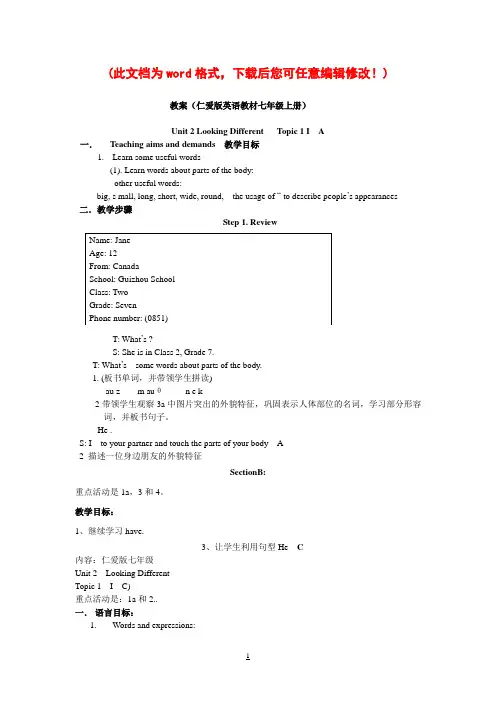
(此文档为word格式,下载后您可任意编辑修改!)教案(仁爱版英语教材七年级上册)Unit 2 Looking Different Topic 1 I A一.Teaching aims and demands 教学目标1.Learn some useful words(1). Learn words about parts of the body:other useful words:big, s mall, long, short, wide, round, the usage of “ to describe people’s appearances 二.教学步骤Step 1. ReviewT: What’s ?S: She is in Class 2, Grade 7.T: What’s some words about parts of the body.1. (板书单词,并带领学生拼读)au z m auθn e k2带领学生观察3a中图片突出的外貌特征,巩固表示人体部位的名词,学习部分形容词,并板书句子。
He .S: I to your partner and touch the parts of your body A2 描述一位身边朋友的外貌特征SectionB:重点活动是1a,3和4。
教学目标:1、继续学习have.3、让学生利用句型He C内容:仁爱版七年级Unit 2 Looking DifferentTopic 1 I C)重点活动是:1a和2..一.语言目标:1.Words and expressions:come,come from,student,sister,different,knife,don’t=do not2.Key sentences:1). I come from England.2). I ’t.4). ---Does ’t.5). ---Do they ’t.3.Teaching important points:1) 学会have 和’t.---Does she ’t.3)IListen to me carefully! Xiao Ming is a boy. He comes from Beijing. He is a student. He the same school, but in different grades.由以上情景导入这部分的新单词,并且引入新内容。
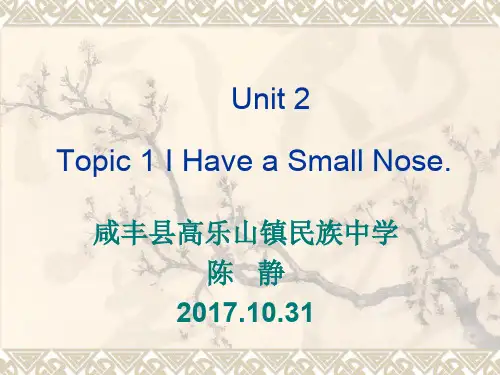
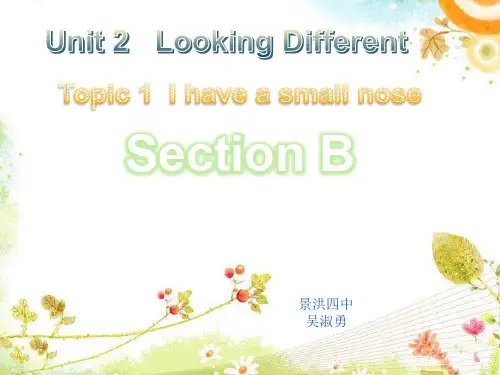
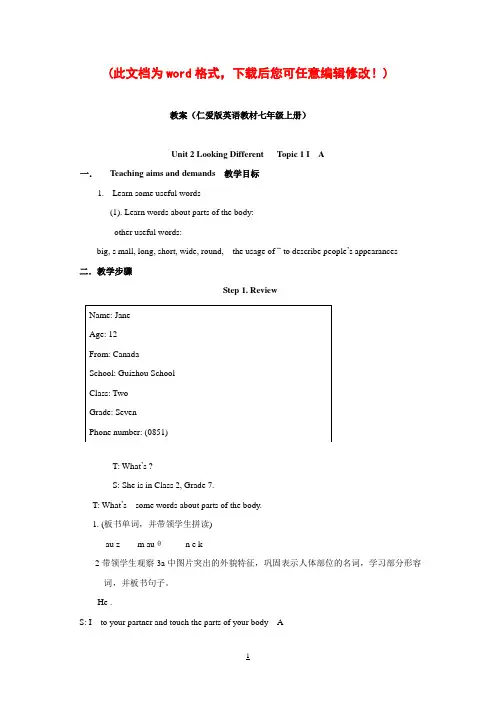
(此文档为word格式,下载后您可任意编辑修改!)教案(仁爱版英语教材七年级上册)Unit 2 Looking Different Topic 1 I A一.Teaching aims and demands 教学目标1.Learn some useful words(1). Learn words about parts of the body:other useful words:big, s mall, long, short, wide, round, the usage of “ to describe people’s appearances 二.教学步骤Step 1. ReviewT: What’s ?S: She is in Class 2, Grade 7.T: What’s some words about parts of the body.1. (板书单词,并带领学生拼读)au z m auθn e k2带领学生观察3a中图片突出的外貌特征,巩固表示人体部位的名词,学习部分形容词,并板书句子。
He .S: I to your partner and touch the parts of your body A2 描述一位身边朋友的外貌特征SectionB:重点活动是1a,3和4。
教学目标:1、继续学习have.3、让学生利用句型He C内容:仁爱版七年级Unit 2 Looking DifferentTopic 1 I C)重点活动是:1a和2..一.语言目标:1.Words and expressions:come,come from,student,sister,different,knife,don’t=do not2.Key sentences:1). I come from England.2). I ’t.4). ---Does ’t.5). ---Do they ’t.3.Teaching important points:1) 学会have 和’t.---Does she ’t.3)IListen to me carefully! Xiao Ming is a boy. He comes from Beijing. He is a student. He the same school, but in different grades.由以上情景导入这部分的新单词,并且引入新内容。
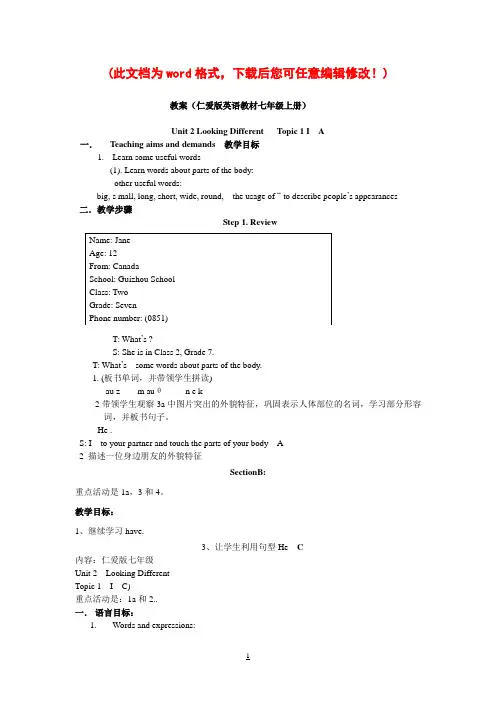
(此文档为word格式,下载后您可任意编辑修改!)教案(仁爱版英语教材七年级上册)Unit 2 Looking Different Topic 1 I A一.Teaching aims and demands 教学目标1.Learn some useful words(1). Learn words about parts of the body:other useful words:big, s mall, long, short, wide, round, the usage of “ to describe people’s appearances 二.教学步骤Step 1. ReviewT: What’s ?S: She is in Class 2, Grade 7.T: What’s some words about parts of the body.1. (板书单词,并带领学生拼读)au z m auθn e k2带领学生观察3a中图片突出的外貌特征,巩固表示人体部位的名词,学习部分形容词,并板书句子。
He .S: I to your partner and touch the parts of your body A2 描述一位身边朋友的外貌特征SectionB:重点活动是1a,3和4。
教学目标:1、继续学习have.3、让学生利用句型He C内容:仁爱版七年级Unit 2 Looking DifferentTopic 1 I C)重点活动是:1a和2..一.语言目标:1.Words and expressions:come,come from,student,sister,different,knife,don’t=do not2.Key sentences:1). I come from England.2). I ’t.4). ---Does ’t.5). ---Do they ’t.3.Teaching important points:1) 学会have 和’t.---Does she ’t.3)IListen to me carefully! Xiao Ming is a boy. He comes from Beijing. He is a student. He the same school, but in different grades.由以上情景导入这部分的新单词,并且引入新内容。
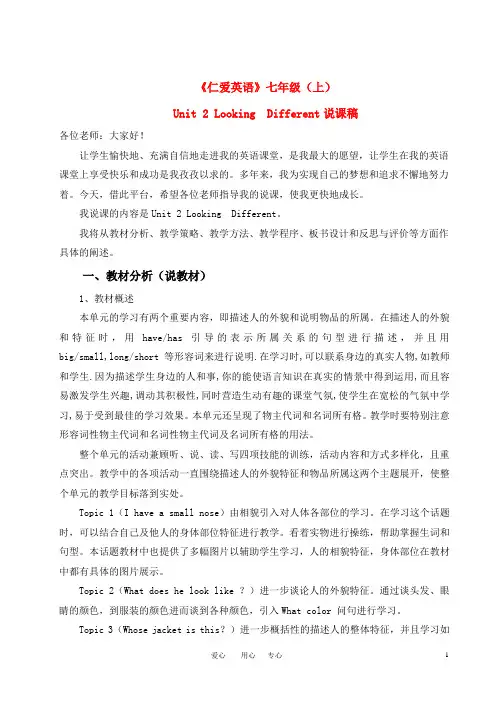
《仁爱英语》七年级(上)Unit 2 Looking Different说课稿各位老师:大家好!让学生愉快地、充满自信地走进我的英语课堂,是我最大的愿望,让学生在我的英语课堂上享受快乐和成功是我孜孜以求的。
多年来,我为实现自己的梦想和追求不懈地努力着。
今天,借此平台,希望各位老师指导我的说课,使我更快地成长。
我说课的内容是Unit 2 Looking Different。
我将从教材分析、教学策略、教学方法、教学程序、板书设计和反思与评价等方面作具体的阐述。
一、教材分析(说教材)1、教材概述本单元的学习有两个重要内容,即描述人的外貌和说明物品的所属。
在描述人的外貌和特征时,用have/has引导的表示所属关系的句型进行描述,并且用big/small,long/short等形容词来进行说明.在学习时,可以联系身边的真实人物,如教师和学生.因为描述学生身边的人和事,你的能使语言知识在真实的情景中得到运用,而且容易激发学生兴趣,调动其积极性,同时营造生动有趣的课堂气氛,使学生在宽松的气氛中学习,易于受到最佳的学习效果。
本单元还呈现了物主代词和名词所有格。
教学时要特别注意形容词性物主代词和名词性物主代词及名词所有格的用法。
整个单元的活动兼顾听、说、读、写四项技能的训练,活动内容和方式多样化,且重点突出。
教学中的各项活动一直围绕描述人的外貌特征和物品所属这两个主题展开,使整个单元的教学目标落到实处。
Topic 1(I have a small nose)由相貌引入对人体各部位的学习。
在学习这个话题时,可以结合自己及他人的身体部位特征进行教学。
看着实物进行操练,帮助掌握生词和句型。
本话题教材中也提供了多幅图片以辅助学生学习,人的相貌特征,身体部位在教材中都有具体的图片展示。
Topic 2(What does he look like ?)进一步谈论人的外貌特征。
通过谈头发、眼睛的颜色,到服装的颜色进而谈到各种颜色,引入What color 问句进行学习。
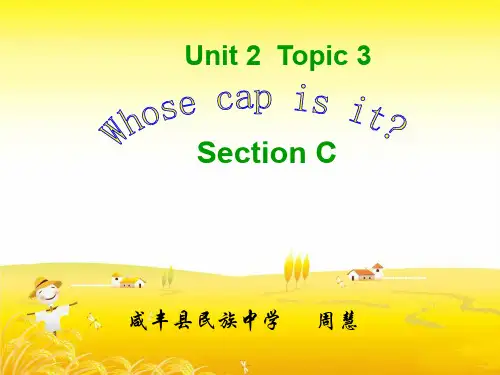
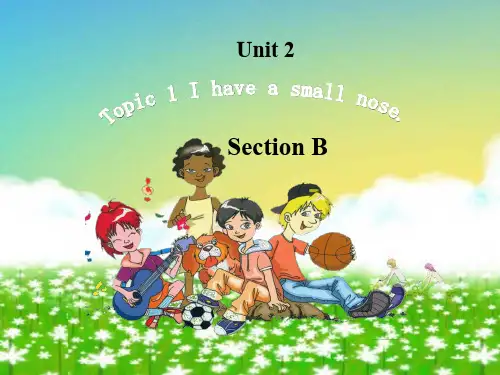

教案(仁爱版英语教材七年级上册)Unit 2 Looking Different Topic 1 I have a small nose.SectionB:重点活动是1a,3和4。
教学目标:1、继续学习have/has的用法。
的用法。
2、继续学习如何描述人的相貌特征。
、继续学习如何描述人的相貌特征。
3、能识别并正确使用不同的声调。
、能识别并正确使用不同的声调。
教学步骤:(一)1、教师利用自己和身边学生的身体特征复习并进一步学习身体部位的名词。
引出并要求学生掌握单词;arm,hand,leg 和foot。
如: T:I have... S:I have... T:She/he have... 同时老师变换人称来复述该同学刚才的回答。
同时老师变换人称来复述该同学刚才的回答。
2、进行身体部位触摸游戏:Bobby Says,完成5b。
3、出示5a中的图片,让学生回答出相应的身体部位的名词。
中的图片,让学生回答出相应的身体部位的名词。
(二)1、老师朗读1a部分的对话,让学生注意自己的语调,并让学生进行跟读。
部分的对话,让学生注意自己的语调,并让学生进行跟读。
2、让学生单独读1a,教师再找出重点句子进行讲解,同时要求学生掌握这些重点句子。
如:如:(1)Who is your favourite movie star? (2)--Does he have long hair? --No,he doesn't. (3)It's bruce Lee. (4)Guess again. 3、让学生利用句型He has...描述成龙。
教师引出句型的不同表达方式并板书。
描述成龙。
教师引出have/has句型的不同表达方式并板书。
S1:He has a big nose. T:His nose is big. S2:He has big eyes. T:His eyes are big. ... 的用法。
在操作过程中,教师要强调is和are,have和has的用法。
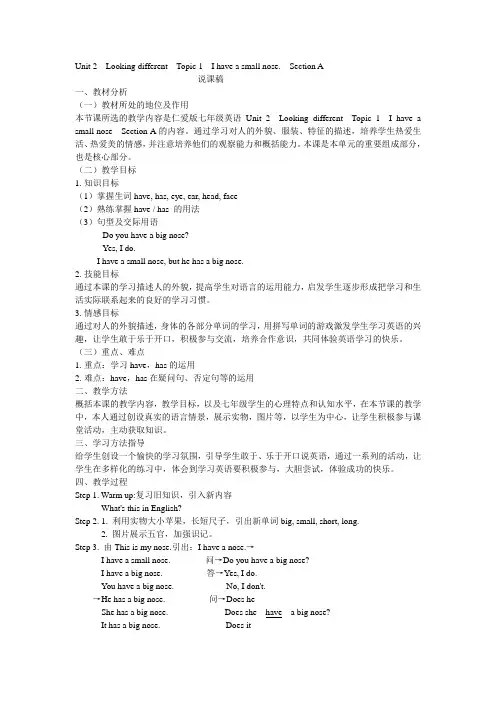
Unit 2 Looking different Topic 1 I have a small nose. Section A说课稿一、教材分析(一)教材所处的地位及作用本节课所选的教学内容是仁爱版七年级英语Unit 2 Looking different Topic 1 I have a small nose Section A的内容。
通过学习对人的外貌、服装、特征的描述,培养学生热爱生活、热爱美的情感,并注意培养他们的观察能力和概括能力。
本课是本单元的重要组成部分,也是核心部分。
(二)教学目标1.知识目标(1)掌握生词have, has, eye, ear, head, face(2)熟练掌握have / has 的用法(3)句型及交际用语--Do you have a big nose?--Yes, I do.I have a small nose, but he has a big nose.2.技能目标通过本课的学习描述人的外貌,提高学生对语言的运用能力,启发学生逐步形成把学习和生活实际联系起来的良好的学习习惯。
3.情感目标通过对人的外貌描述,身体的各部分单词的学习,用拼写单词的游戏激发学生学习英语的兴趣,让学生敢于乐于开口,积极参与交流,培养合作意识,共同体验英语学习的快乐。
(三)重点、难点1.重点:学习have,has的运用2.难点:have,has在疑问句、否定句等的运用二、教学方法概括本课的教学内容,教学目标,以及七年级学生的心理特点和认知水平,在本节课的教学中,本人通过创设真实的语言情景,展示实物,图片等,以学生为中心,让学生积极参与课堂活动,主动获取知识。
三、学习方法指导给学生创设一个愉快的学习氛围,引导学生敢于、乐于开口说英语,通过一系列的活动,让学生在多样化的练习中,体会到学习英语要积极参与,大胆尝试,体验成功的快乐。
四、教学过程Step 1. Warm up:复习旧知识,引入新内容What's this in English?Step 2. 1. 利用实物大小苹果,长短尺子,引出新单词big, small, short, long.2. 图片展示五官,加强识记。
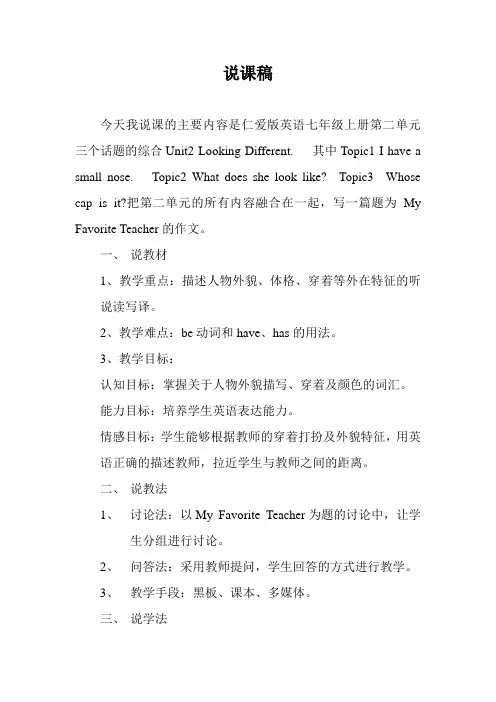
说课稿今天我说课的主要内容是仁爱版英语七年级上册第二单元三个话题的综合Unit2 Looking Different. 其中Topic1 I have a small nose. Topic2 What does she look like? Topic3 Whose cap is it?把第二单元的所有内容融合在一起,写一篇题为My Favorite Teacher的作文。
一、说教材1、教学重点:描述人物外貌、体格、穿着等外在特征的听说读写译。
2、教学难点:be动词和have、has的用法。
3、教学目标:认知目标:掌握关于人物外貌描写、穿着及颜色的词汇。
能力目标:培养学生英语表达能力。
情感目标:学生能够根据教师的穿着打扮及外貌特征,用英语正确的描述教师,拉近学生与教师之间的距离。
二、说教法1、讨论法:以My Favorite Teacher为题的讨论中,让学生分组进行讨论。
2、问答法:采用教师提问,学生回答的方式进行教学。
3、教学手段:黑板、课本、多媒体。
三、说学法学生通过分组讨论法及合作学习法,对本节课进行学习。
四、说教学过程Step1: Leading-inLet’s chant. head and shouldersStep2: Study of the introduction将我们学校英语教师的图片展示给学生看,引入本节课的主题My Favorite Teacher。
Step3: Lean how to write a composition about My Favorite Teacher。
其中分为三个部分:beginning (开头)、body (正文)和ending(结尾)。
Step4: How to write a composition about beginning.关于描述一个教师的开头,我们可以用This is my….She/He is...years old. She/He is a girl/boy. She/He is from… His/ Her telephone number is…Step5: How to write a composition about body关于描述一个教师的正文部分,我从三个方面着手。
1 Unit 2 Looking Different Topic 1 I have a small nose. Section A The main activities are 1a, 2a and 3a. 本课重点活动是1a, 2a和3a。 Ⅰ.Teaching aims and demands 教学目标 1.Learn some useful words: (1)Learn words about parts of the body: nose, eye, head, face, hair, ear, mouth, neck (2)Learn other useful words: guess, have, small, has, big, know, right, round, long, wide, girl, boy, short 2. Learn the simple present tense with“have/has”and adjectives of description: (1)I have a small nose. (2)They have round faces. (3)She has long hair. (4)It has big ears. 3. Learn how to describe people’s appearances. Ⅱ. Teaching aids 教具 小黑板/影片的封面或图片/录音机/教学挂图 Ⅲ. Five-finger Teaching Plan 五指教学方案
Step 1 Review 第一步 复习(时间:10分钟) (出示小黑板上的图画和信息,师生进行互动问答,后让学生两人一组对话表演。复习描述 人的基本情况。)
Name: Jane Age: 12 From: Canada School: Beijing Ren’ai International School Class: Four Grade: Seven Phone number: (010)9267-6929 2
(1)T: What’s her name? S1: Her name is Jane. T: How old is she? S2: She is twelve. T: Where is she from? S3: She is from Canada. T: What class is she in? S4: She is in Class Four, Grade Seven. T: What’s her telephone number? S5: It’s (010)9267-6929. (把全班学生分成两组就此对话表演。) (2)(根据图画导入新内容。) T: Well done! Now we have learned something about Jane. Do you like her? Is she beautiful? Then how to describe her appearances? First let’s learn some words about parts of the body. Now look at the picture.
Step 2 Presentation 第二步 呈现(时间:12分钟) 1. (教师利用Jane的图片教授2a中人体各部分的名称,并在图片的相应位置板书单词后领学生拼读。注:教师在讲授过程中,可根据人体器官的从上到下、从局部到整体的顺序进行讲解。) 2. (出示3a的教学挂图,让学生观察图片中突出的外貌特征,巩固表示人体部位的名词,学习部分形容词。)
a big nose small mouths round faces long hair a wide mouth big ears 3. (在熟练掌握人体部位和描述人体部位形容词的基础上,结合3a的教学图片,让学生操练形容词+人体部位的短语,然后教授have和has的用法,进而过渡到完整的句子。) (教师说出一个人称代词,让学生结合3a的教学挂图说出用have还是用has。) T: Look at Picture 1. “I …” 3
Ss: I have. T: The whole sentence.(“完整的句子”) Ss: I have a big nose. T: Picture 2. “We …” Ss: We have. (教师示意说完整的句子。) Ss: We have small mouths. … 4. (听3a录音,让学生跟读并注意语音语调。) T: Listen to 3a and repeat. Pay attention to the pronunciation and intonation. 5. (1) (总结have/has的用法并板书在黑板上。) T: Let’s sum up the usages of“have”and“has”. ① have: S(I/We/You/They) +have … ② has: S(He/ She/ It)+has … (2) (教师带领学生运用身边的实物练习用have/has造句。) T: I have a book. She has a pencil-box. He has a beautiful bag. …
Step 3 Consolidation 第三步 巩固(时间:8分钟) 1. (小组竞赛。限定时间要求学生书面完成3b。核对答案,并让学生复述have/has的用法,最后让学生齐读这七个句子。) 2. (接龙游戏。老师根据自己的实际情况以第一人称说一个句子,学生模仿练习。) T: I have a big nose. Please use “I have …” Begin! S1: I have a small nose. S2: I have a long face. S3: I have a big head. S4: … … 3. (根据学生的描述,有意识板书一些句型,运用肢体语言,引导学生进行替换练习。) Huang Lin: I have a small nose. Huang Hao: I have a small nose. (引导他们用we来描述,注意单复数形式,其他同学用they转述。) Huang Lin and Huang Hao: We have small noses. Ss: They have small noses. (引导其他同学来描述) 4
Lin Yin(女): I have long hair. Ss: She has long hair. Chen Bin(男): I have big ears. Ss: He has big ears. 4. (请学生根据描述,完成4。) T: Read the passages and draw pictures. 5. (两人一组,一位描述,另一位画,画完后同桌交流。每一小组评出画得最好的,老师可以把好的贴在墙上,以资鼓励。) T: Let’s draw a picture in pairs. One reads, the other draws. Are you ready? S1&2:Yes. T: Let’s begin. S1: This girl has a round face, big eyes … S2: (根据S1的描述画女孩的面部特征) …
Step 4 Practice 第四步 练习(时间:8分钟) 1. (利用课前准备好的影片的封面或图片进行问答,问答过程中板书新内容并进行简单解释。) T: Do you know the man? Ss: Cheng Long. T: Yes, you’re right. (板书) know I know. right You’re right. 2. (听1a录音,学生跟读并让学生注意语音语调,然后判断下列问题的正(T)误(F)。) T: Listen to 1a and repeat. Pay attention to the pronunciation and intonation. Then mark the following sentences True (T) or False (F). (1)Michael has a big nose. ( ) (2)Kangkang has a small nose. ( ) 3. (让学生利用面具两人一组表演,完成1b。) T: Now practice the dialog and then I’ll ask two students to act it out. 4. (看2a部分,用适当的形容词描述人体部位的特征。) 5. (学生两人一组进行表演,完成2b。) T: Listen to your partner and touch the parts of your body he/she says. S1: Touch your nose. S2: (按S1指令做出相应动作) … 5
Step 5 Project 第五步 综合探究活动(时间:7分钟) 1. (教师分别叫一男生、一女生先后到黑板前,请大家描述他们的外貌,教师先示范,然后以滚雪球的方式继续活动。) (1) T: This boy has a round face. S1: He has a round face and small eyes. S2: He has a round face, small eyes and a big nose. S3: … (2) T: This girl has long hair. S4: She has long hair and a big nose. S5: She has long hair, a big nose and a small mouth. S6: … 2. (听音辨人,从所听语段中获取相关信息,并作出判断。) T: Let’s play a guessing game. Listen carefully. He is a boy in Group Five. He has big eyes and big ears. He has a small face and a big head. He has a small nose and long hair. Who is he? S1: Lin Wen. T: No. S2: Lin Fen. T: Yes, you’re right. (掌声鼓励。) (分组进行听音辨人游戏。) T: Now I’ll divide our class into four groups. Do as I do, please. … 3. Homework: (1)复习Section A。 (2)预习Section B生词。 (3)描述一位你的朋友的外貌。 板书设计: I have a small nose. Section A 1. (1)I have a big nose. (2)We have small mouths. (3)They have round faces. I/We/You/They + have … (4)She has long hair. He/She/It + has … (5)He has a wide mouth. (6)It has big ears. 2. I know. 3. You’re right.